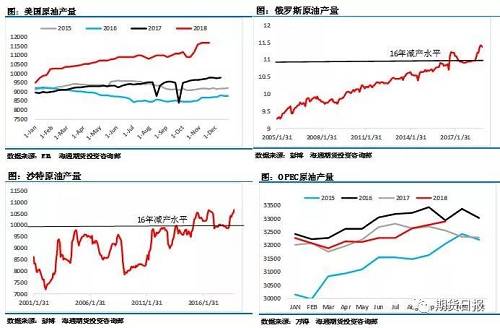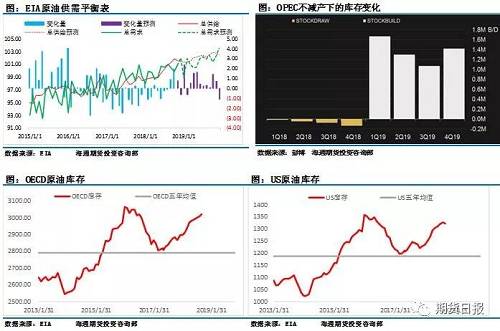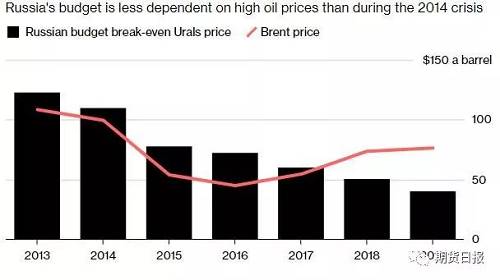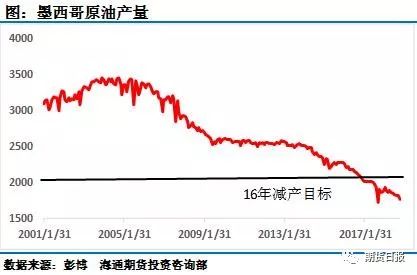OPEC+ talks drama will be staged, please accept this "watching guide"
On December 6, the OPEC+ conference, which is related to the trend of crude oil prices in the next half year, will be held. At this key node, OPEC+ this meeting can bear too much responsibility and pressure, and it is also a key factor in the future oil price trend.
Since the beginning of October, WTI crude oil prices have dropped from a high of 76.9 US dollars to 49.4 US dollars, in a short two months, the cumulative decline of 27.5 US dollars, a drop of up to 35%! On the edge of the collapse of crude oil prices, when all the eyes of the market are focused on the OPEC+ meeting, will short-term oil prices continue to collapse? Will the future oil price return to a high point? It seems to have to watch the OPEC meeting!
First, the current status of the market
The current market, with a serious supply surplus, can be described as no exaggeration. With the increase in global crude oil production at high oil prices, the supply of crude oil has already experienced a serious surplus.
The first major impact on supply is the US shale oil production. After surpassing Russia in August, the US production has successfully become the world's largest crude oil producer, and its growth momentum has not shown signs of slowing down in the short term.
Russia is the main force in the last reduction of production agreements in non-OPEC countries, but we have seen that Russia’s production has not only increased sharply in recent years, but has even surpassed the highest value in the former Soviet Union. Under the full increase of production in Russia, the previous production reduction agreement has also changed. Named to die.
Since the outbreak of the Kashuji incident in Saudi Arabia, the independence of national policies has been left behind. The energy policy is naturally not self-sufficient. In short, it is better to sacrifice the interests of the big guys and to preserve the position of the Saudi Crown Prince. So we saw that Saudi Arabia seems to have changed its face. The 80-dollar oil price that is often hung on the lips is no longer mentioned. The market surplus is no longer mentioned. It is the only task to fully exploit the oil to meet the US’s mandate. aims.
At this point, the production reduction agreement reached at the end of November 2016 has completely become a waste paper...

Second, the urgency of reducing production
According to the EIA data, according to the current market development, the whole year of 2019 will remain in a pattern of severe oversupply. The high growth of supply and the decline in potential demand have caused the price of crude oil to plummet within two months. If the situation is still maintained in 2019, the consequences are really unimaginable.
From the perspective of inventory, if the OPEC meeting fails to reach a production reduction agreement in these two days, then the inventory structure in 2019 will be very ugly, and the speed of the global inventory will be above 1 million barrels per day, 2019. In the first quarter, it will reach a huge increase of 1.6 million barrels per day.
From the current inventory structure, the accumulation of inventory seems to have begun. From last week's EIA data, we can see that the current US refinery operating rate has rebounded sharply, and refinery overhaul has basically ended, but we still see the growth of US crude oil inventories. According to seasonality, the current US crude oil inventories have reached the point of destocking, but this year's destocking seems not to arrive. The API data released on Tuesday showed that US crude oil inventories continued to grow, so it is not excluded that this week's inventory data will continue to increase substantially...
OECD's crude oil inventories have returned to near the highest point, when the last OPEC+ began to cut production, the goal of returning to the five-year average was only loose for a short period of time. According to the current accumulative inventory speed, if the production reduction agreement fails, we can think that the tanker floating around the world is not transporting crude oil, but because the onshore inventory is close to saturation.
Therefore, in the current market environment, OPEC+ urgently needs to cut production to stabilize the market, otherwise waiting for oil prices will be another abyss...

3. Can OPEC finally reach a production reduction agreement?
Before entering December, we have a clear view on OPEC's agreement to reduce production. The author believes that OPEC must reach a production reduction agreement to stabilize the market. Although OPEC faces more difficulties and difficulties than last time, Saudi Arabia will lead OPEC to stabilize again. The role of the market, after all, even if there is no market intervention to interrupt the market, OPEC will not escape this fate in the future.
However, according to the current news, there is some loosening in this view. The contradiction within OPEC is far greater than our imagination. Let's take a closer look at the views of major OPEC members on reducing production.
Saudi Arabia
2016 benchmark output 丨104.33 million barrels / day
The number of production reductions in 2016 was 486,000 barrels per day.
2016 production reduction target 丨99.47 million barrels / day
The latest production in 2018 is 11.3 million barrels per day.
As the "big brother" of OPEC, Saudi Arabia shoulders the important role of leading the policy. Before the Kashoji incident, we saw a confident Saudi Arabia, the Saudi Arabian oil with a price of 80 US dollars, and Saudi Arabia who said that OPEC should be policy-independent.
However, after the Kashoji incident, Saudi Arabia’s attitude has undergone a significant change. People have to bow their heads under the roof. Saudi Arabia has reduced the slogan of singing more oil prices, and the sneak increase in production has suppressed the price of crude oil. At this time, Saudi Arabia still did not give up the idea of ​​reducing production. Earlier, Saudi Arabia said it would cut production and exports in December to stabilize the market, and said it would join Russia to lead OPEC+ to reach a new production reduction agreement. Obviously, Saudi Arabia still avoids the attitude of the United States at this time, and secretly reducing production is one of the potential options.
The recent change in Saudi attitude stems from Qatar’s announcement that it will withdraw from OPEC in January 2019. Saudi Energy Minister Falih said that he did not know how much it needed to cut production. It is still too early to say whether it will cut production. According to sources, OPEC may postpone the decision to cut production if Russia does not agree to continue to cut production.
The change in Saudi attitude has caused us to lose some confidence in the production reduction agreement. If Saudi Arabia does not actively promote the production reduction agreement, then who can have such a big appeal? Who will bear the main production reduction tasks?
On the other hand, Saudi Arabia does have an urgent need for high oil prices to support domestic reforms and economic plans. The Saudi Crown Prince is a politically ambitious person and a courageous person. His political ambition is based on the high oil prices that bring stability. Fiscal revenue, so the current Saudi Arabia is also caught in a contradictory situation. It is the truest portrayal of the Saudi Crown Prince that he dares to speak out for low oil prices.
At present, Saudi Arabia still has a large degree of uncertainty. The main reason for this uncertainty is the degree of cooperation between the US and the United States. If Russia can better cooperate with Saudi Arabia to reduce production, then the probability of passing the production reduction agreement is quite good. High.
Qatar
2016 benchmark output 丨641,000 barrels / day
The number of production reductions in 2016 is 30,000 barrels per day.
2016 production reduction target 丨611,000 barrels / day
The latest output in 2018 is 610,000 barrels per day.
Although Qatar claims to withdraw from the OPEC organization has nothing to do with politics, but who believes? Qatar does not want to offend the United States, does not want to offend Saudi Arabia, and does not want to cut production. Some analysts said that Qatar has been disappointed with OPEC. The main reason is that OPEC's influence is not as good as before, and Saudi Arabia and Russia have dominated OPEC's direction, and OPEC has lost its independence. Qatar has withdrawn from OPEC and is able to make an independent energy policy based on its own situation. At present, Qatar's crude oil production is only 610,000 barrels per day. The overall impact of his withdrawal on OPEC production is not great.
We are not worried about the actual number of Qatar's exit from OPEC to reduce production. We only worry that Qatar's spillover effect is too strong, and other OPEC oil producing countries will also be the shopkeepers if they are not paid attention. It is important to know that Saudi Arabia is willing to promote the production reduction agreement because other countries can help them share most of the tasks. Once OPEC falls apart, Saudi Arabia’s appeal will be greatly weakened. If Saudi Arabia wants to maintain market stability, it needs to make more It is almost impossible for Saudi Arabia to make a big reduction in production and make more sacrifices.
Iraq
2016 benchmark output 丨 4.642 million barrels / day
The number of production reductions in 2016 is 210,000 barrels per day.
2016 production reduction target 丨 4.432 million barrels / day
The latest production in 2018 is 4.69 million barrels per day.
The Iraqi oil captain said that OPEC’s approach to solving oil prices is not limited to reducing crude oil production. Iraq is currently seeking to increase production and increase exports. It has been reported that the Iraqi government and the leaders of the Kurdish autonomous region in the north of the country have reached an agreement on restoring oil exports to the Kirkuk oil field. But for Iraq, current production is nearing the upper limit, and a small reduction in production may be acceptable for Iraq.
Venezuela
2016 benchmark output 丨2.034 million barrels / day
The number of production reductions in 2016 is 95,000 barrels per day.
2016 production reduction target 丨1.939 million barrels / day
The latest output in 2018 is 1.27 million barrels per day.
It can be said that OPEC's production reduction rate is so high and has a direct relationship with Venezuela. Under the continuous sanctions of the United States, in line with the domestic environment in Venezuela, the natural decline in crude oil production has caused it to lose nearly 800,000 barrels per day of market share, which also makes its production reduction task more than expected. At present, Venezuela's production decline has gradually stopped. Later, in the case of stable domestic environment, a substantial increase in production back to the expected production level should be its main target. Therefore, we speculate that Venezuela may apply for immunity in the production reduction agreement, even if Without being exempted, Venezuela may agree to continue the 16-year production reduction agreement.
Iran, Libya, Nigeria
2016 benchmark production 丨375, 58, 1.65 million barrels / day
Quantity reduction in 2016, exemption
Latest production in 2018 丨372, 122, 1.82 million barrels / day
Looking at the three exempt countries, the output of the two other oil-producing countries except Iran has increased substantially. The decline in Iran's production is due to the recent re-implementation of sanctions by the United States, otherwise crude oil production will increase substantially. Of the three exempt countries, Libya's production has increased significantly in the near future, and there is still at least 400,000 barrels per day of growth from the high point of production. Nigeria's production is also steadily rising, with a growth rate of 200,000 barrels per day from the high point of production. However, in this production reduction agreement, except for Iran, Libya and Nigeria may be required to join the ranks of production reduction. We think that these two countries may agree. The main reason is that Libya's current surplus capacity is insufficient. Even if it does not join the production reduction agreement, Libya's production will face a natural decline in the near future.
Nigeria’s oil minister has stated his commitment to cooperation with OPEC.
Therefore, from the OPEC countries outside Qatar and Saudi Arabia, the willingness to participate in production cuts is still quite strong. Therefore, whether the final production reduction can be achieved depends mainly on whether Saudi Arabia will fully promote and come up with a solution acceptable to all oil-producing countries. If Saudi Arabia is not afraid of US deterrence and is willing to exchange interests with Russia, then we believe that the production reduction agreement will implement.
4. Will non-OPEC countries give strength?
Among the non-OPEC production reduction agreements, the most important oil producer is Russia. Russia is not only the main force in reducing production, but also a key factor in the OPEC countries' agreement to reduce production. So will this non-OPEC country continue to be as strong as it was last time? We have sorted out the current market situation of major oil producing countries.
Russia
2016 benchmark output 丨 11.23 million barrels / day
The number of production reductions in 2016 is 300,000 barrels per day.
2016 production reduction target 丨10.93 million barrels / day
The latest output in 2018 is 11.411 million barrels per day.
Whether Russia will reduce production will directly affect the overall production reduction effect. As far as the current situation is concerned, Russia's tolerance for low oil prices has increased substantially. Whether or not to reduce production depends on the fact that the interests of Russia and Saudi Arabia can be hit. Putin said earlier that the cooperation with OPEC to stabilize the oil market has shown positive results, but he pointed out that the price of oil is around US$70 per barrel. He will not promise to support prices by reducing production. Russian Energy Minister Novak said that producers need to better understand the current situation and winter prospects before agreeing to limit supply.
However, after the previous oil price continued to fall, Russia said that it had already prepared for cooperation with OPEC countries, and also proposed its own production reduction plan, which is to gradually reduce production as it was last time, instead of completing it immediately. After the G20, we saw that the market has said that if Russia does not participate in production cuts, OPEC countries will not cut production. Is this a threat to OPEC countries to Russia? Or is the attitude of Russia in the G20 changed? We have not seen the relevant news yet.
However, it seems that Russia may have a high probability of participating in the agreement to reduce production. Russia's current crude oil production has reached a new high. If the production is reduced according to the October production, Russia has the ability to reduce production. And if Russia cooperates with Saudi Arabia, it will gain higher political interests, which is far greater than the lost economic interests. Why is Russia not happy?

Mexico
2016 benchmark output 丨2,033,000 barrels / day
The number of production reductions in 2016 is 100,000 barrels per day.
2016 production reduction target 丨200.3 million barrels / day
The latest output in 2018 is 1.811 million barrels per day.

Mexico’s performance in the last production cuts was impressive, mainly due to the continued decline in production caused by the aging of the Mexican oil fields. Mexican state-owned oil companies expect Mexico's oil production to increase to 1.85 million barrels per day by 2019, and the government's goal is that production will not decline naturally next year. In contrast, the IEA expects that by 2019, the daily production of Mexican oil, including crude oil and condensate, will fall from 2.1 million barrels in 2018 to 1.99 million barrels. The natural decline may allow Mexico to join the production reduction agreement again. Come in.
Oman
2016 benchmark output 丨101.2 million barrels / day
The number of production reductions in 2016 was 45,000 barrels per day.
2016 production reduction target 丨967,000 barrels / day
The latest output in 2018 is 97.4 million barrels per day.
Oman’s oil chief said in the early days that the oil market was over-supply. If crude oil supply maintains the status quo, OPEC and non-OPEC countries agree that action is needed. This attitude of Oman shows that if OPEC countries can have substantial measures, Oman is likely to join the ranks of production reduction again.
Asaby
2016 benchmark output 丨814,000 barrels / day
The number of production reductions in 2016 is 35,000 barrels per day.
2016 production reduction target 丨79,900 barrels / day
The latest output in 2018 is 783,000 barrels per day.
The situation in Azerbaijan is similar to that in Mexico, and the natural decline in production has made it less costly to participate in production cuts, so in 16 years Azerbaijan has also become one of the countries that have reduced production. However, in 2019, BP's new oil project will be put into production. It is expected that the natural decline in production in Azerbaijan will end, and it is expected that production will rebound. Therefore, it is difficult to say that Asa is in this case. Join again in the ranks of production cuts.
Among the OPEC countries, Saudi Arabia is mainly seen. Non-OPEC countries mainly look at Russia. As long as these two countries can reach an agreement, the possibility of participation by other oil-producing countries is still relatively large. However, the current situation seems to be in Russia. Some sources said that Russia hopes to only carry out "symbolic reductions". Even if Russia only agrees to "symbolic reductions", OPEC+ can reach an overall agreement. But the problem now is that Russia has so far failed to support Saudi Arabia’s proposal to cut production by at least 1 million barrels per day. Russian Energy Minister Novak and Saudi Energy Minister Falih will hold talks before the OPEC meeting. The outcome of this talk will directly determine whether OPEC+ can continue to reach a production reduction agreement.
V. OPEC meeting results prediction and possible oil price trend
From the current situation, it is more difficult to accurately predict whether OPEC+ will reach a production reduction agreement, but we still prefer Saudi Arabia and Russia to achieve the desired results, that is, Russia will eventually agree to join the production reduction. It may be really just a symbolic participation.
Based on the current market situation, we believe that the OPEC+ conference results have the following possibilities:
Achieved a reduction of 1 million barrels per day agreement (probability 50%)
This is currently recognized as a reduction in production on the market and is the biggest expectation of the market. If the production of 1 million barrels is reduced, then the short-term crude oil price will be bullish, the crude oil price will change the previous weakness, sit in the bottom section and make a big upside, Brent price may exceed 70 US dollars.
Achieved a 100+000 barrel/day agreement (10% probability)
There are rumors of 1.4 million barrels per day in the market, but it is not a mainstream expectation. We don’t expect the reduction in production to be so large. If the final result is really 1.4 million barrels per day, then the stimulus for oil prices is much greater than 1 million barrels per day, driven by lower-than-expected production cuts, crude oil prices will rise quickly, and Brent prices will reach above $75.
Achieved a reduction of 100,000 barrels per day agreement (probability 10%)
There are also 700,000 barrels per day in the market. This kind of expectation is also a small group. If the output is reduced by 700,000 barrels per day, the reduction in production is equivalent to lower than expected. The price of crude oil may not change much. You will still be looking for a break up or down in the current bottom range.
Production reduction agreement delayed or lost (probability 30%)
This situation depends on whether Russia is willing to cut production or not, and to what extent the talks between Saudi Arabia and Russia will proceed. If the final production reduction agreement is not reached, the short-term price will fall again into the abyss, and the Brent price will advance to $50.
Regardless of the final result, what we need to do now is to control the risk and wait patiently. Livermore has a famous saying: When you walk on the rails and there is a train coming to you, all you need to do is jump off the rails. When the train leaves, you can return to the rails whenever you want. Above.
The POLYKEN 980,955 is a multi layer system used for the protection of steel pipelines. POLYKEN 1019,1027, Liquid Adhesives can be used as primers for this system.In addition to serving as primers, these liquid adhesives themselves represent an anti corrosion layer and provide a uniformly smooth contact surface to promote high adhesion of the coating system to the pipe. They are designed for machine or brush application and formulated with stress-corrosion cracking inhibitors. The Anti-Corrosion layer POLYKEN 980 is engineered to assure a high bond to the primed surface with excellent conform ability characteristics. The mechanical protection layer POLYKEN 955,achieves a complete bond to the POLYKEN 980 inner layer, providing maximum handling and in-service protection for the coating system. The adhesives in these and all POLYKEN tape systems contain proven anti-microbial additives.The POLYKEN 980/955 can also be used for ductile iron pipes, in this case the use of 1027 primer is recommended.

Polyken 955 (Outer Wrap)
Outer Wrap Tape, Anti corrosion Tape,Oil Pipe Wrap Tape,Pipeline outer Tape,Polyken955 Adhesive Tape,Polyken955 Outer Tape,outer tape,corrosion protection tape,corrosion protective tape
Jining Qiangke Pipe Anticorrosion Materials CO.,Ltd , https://www.pipe-wrap-tape.com